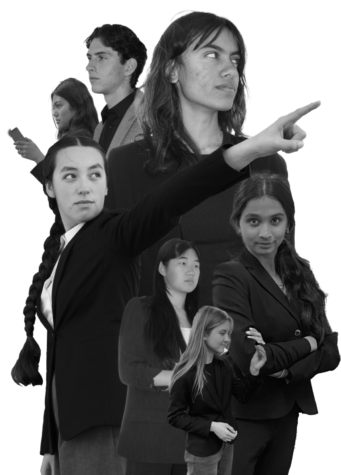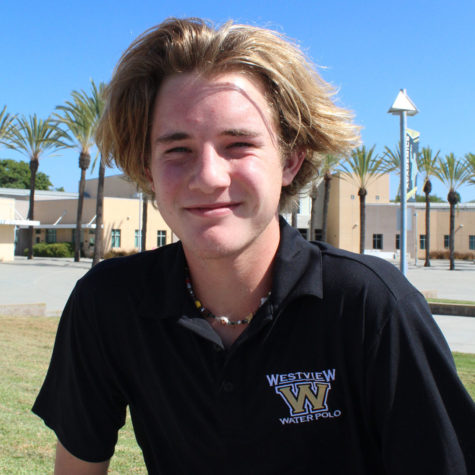Mock Trial wins Counties
March 17, 2023

This year, the Westview Mock Trial Team was by no means the underdogs. A string of finals wins, runner-ups and top-fives for San Diego County within the past couple of years had netted them the reputation as one of the most formidable teams in San Diego County. But as captain Swasti Singhai (12) was driving up to the courthouse on February 28th for this year’s Mock Trial final, she couldn’t help but feel like they had fought against all odds to get there.
The team had been dealt a blow at the end of last season—the absence of graduated members meant that they had lost seven out of their eight attorneys and two of their witnesses.
The eighth attorney who remained was Singhai who, along with her co-captain Brad Brady (12) and their coach Scott Taylor, made it their mission to prepare the team for next season. The team assumed it was preposterous to think that they would win this year so they started out with a goal of working towards building up the team for next year.
“Our goal wasn’t really to win, even though that’s [usually] our goal,” Singhai said. “It seemed unfeasible to even win, really, because everyone was so new, so we just focused on learning and setting a foundation.”
This year the case was one of battery and robbery on the high seas: a ring supposedly owned by Shakespeare was stolen from an actor who performed on a cruise liner.
Teams are given a case packet at the start of the season which contains 90 pages of witness testimonies, room dimensions and other facts of the case. They use these facts to build up both a prosecution and a defense.
Practices were held Thursdays and Sundays, but often the team spent time outside of practice to, well, practice. In particular, the new set of attorneys had to work extra hard in order to understand both the complications of the case at hand and their roles in the courtroom.
Cora Reyes-Castelloe (11) and Grace Tseng (11) were two of these new attorneys. They understood the importance of their roles and poured their all into understanding their position within the team.
“I read the case packet, until I probably needed glasses, just over and over again,” Reyes-Castelloe said. “I took the time out of my day to work on my own. I looked up videos of courtroom lawyers. I looked up [previous] Mock Trial cases, their Mock Trial blogs, and Mock Trial articles.”
Outside of personal research, there was a lot of collaboration in order to get the attorneys into shape. Singhai was the only source they had, besides the coaches, for experience in that field, so she took time during the season to work with her attorneys.
“Swasti met with us [individually] on Zoom like every single day for weeks,” Tseng said. “She met with a different person each day to run objections, help us write directs [and] edit all of our scripts.”
Slowly but surely, the team began to find their footing. As they peeled through the facts of the case, they began to form compelling arguments, and as they learned from Singhai, Taylor and Brady they began to understand the courtroom.
As scrimmages began, the coaches and Singhai focused on correcting the mistakes so that the teams were flawless come the championship for San Diego County.
“[We] were big on constructive criticism,” Singhai said. “We scrimmaged a ton, almost every weekend until counties. We didn’t approach each scrimmage with the goal of beating the other team, but rather improving ourselves. Eventually, we began to feel more prepared.”
Soon came the San Diego County finals and the team began to see the rewards of all their hard work. The team went 3-1, tying them with three other teams for second place. However scores were not merely based on wins and losses but also their point scores for each section of the trial. The performance of the attorneys and witnesses in the courtroom leads to an overall point total which is what causes a win. Westviews wins were by the highest point differential of any of the teams meaning they would advance.
They were going to finals.
Three days later, on February 28th, was the big day. The team entered the finals courtroom as a singular unit, a group formed together through their hard work and molded in their previous success. The room was accentless, windowless and a dull ’70s beige. Nothing to distract, everything to keep the trial in focus.
The team split into two. Singhai along with the rest of the prosecution sat in the back while Brady, Tseng, Reyes-Castelloe and the defense made their way to the front.
And so it began.
Brady began his pretrial argument, questioning a particular piece of evidence that could prove crucial to the prosecution’s argument, if it wasn’t struck down. .
Unfortunately, defense was always an uphill battle for Brady. The facts of the case were simply stacked against him with little to no room for him to win, barring a major mistake from the other side.
Fortunately for Brady and the team, he was not scored on outcome, but instead, on how he performed. And performance was Brady’s specialty.
When Brady competes he adds an air of calm to, he is known for his ability to charm the judges with his knowledge of the case and calm . Brady says that finals was the first time throughout the season where he truly felt in the zone.
“Scott told us one day, you’ll be at this happy place where you can answer these questions flawlessly, you’ll know what you’re doing, you’re gonna walk into that program, and you’re going to be the one who knows the most about the case going in,’ Brady said. “And I remember at that point, I said to him, Well, I’m not at that happy place right now. I think that finals round was the first time I actually felt that way.”
As predicted, the evidence was passed through and Brady’s motion was denied; however, Brady’s excellent performance nullified any worries this caused.
Then came the directs, where the facts and themes of the case are presented by the attorneys. The prosecution, Scripps Ranch High School, was up first. The attorney stood up from her chair and began walking around the courtroom as she talked, instead of using the podium like usual. They argued that the stealing of the ring was caused by a metaphorical big green monster—jealousy, jealousy that only the defendant could have.
Tseng was initially flustered by her theatrics. She said she wasn’t sure if she should mirror the walk-and-talk style or stick to her guns and stay at the podium.
“Her walking really psyched me out,” Tseng said. “And I was like, ‘should I walk today?’ But then, I ultimately decided not to and I think I’m glad I chose not to because not having a lot of bells and whistles [is] one of our strengths.”
Tseng opened with Westview’s theme, that this crime could have been committed by anyone. She was clear and direct. Tseng exuded an air of control over the facts she presented, calm and stern yet also passionate about defending her client.
Then came witness testimonies, and cross examinations of said witnesses. Both sides hammered hard into their themes and used their evidence expertly.
Singhai said it was hard to tell who would win at this point. Westview had provided a clear eviscerating cross, but Scripps had a theatrical control of the courtroom that could potentially give them the edge.
Thus came the final thing that could give Westview the edge to win: closing statements, where teams conclude their arguments and afterwards rebuttal the opposing sides closing.
These duties fell upon Reyes-Castelloe’s shoulders. Most would have crumbled from the pressure—points were doubled, meaning any um’s or slurred words could lead to a tragic loss.
But Reyes-Castelloe was anything but nervous. Standing there at the speaker’s podium, she seemed hypervigilant, almost excited to speak.
She asked for the time she had left–only a certain amount was given for speaking. Four minutes and 36 seconds. A short amount of time all she needed to do was burn down the prosecution’s closing.
And she had plenty of kindling.
“Your honor, the prosecution has spoken a lot today about jealousy, and a green-eyed monster. There is a bigger monster, though, the worst monster of all, and it is ignorance, because it is the monster you cannot see. This crime could’ve been committed by anyone, and prosecution has failed to meet their burden of proving guilt beyond a reasonable doubt.”
Her words echoed through the courtroom. Instantly the defense knew they had an upper hand.
“We all looked at each other [because] that was the moment where we knew she was going to kill with her score,” Tseng said. “And you could tell the judges and scores really liked it [too].”
After a short deliberation, the scores were in. Not only had the defense won the case, but also scored higher in presentation of the case.
Westview had won.
“It felt really good,” Singhai said. “When I found out I won, I started crying. It was a really emotional moment [because] making it this far was already such an accomplishment. And to do it for a second year in a row, despite having a younger team, made it feel like all of our practice and all of our scrimmages paid off.”
The team celebrated with a dinner at the only place open at midnight, Denny’s. Downing pancakes, eggs and bacon washed down with OJ the team.
Later today the team will be competing in the first round of States, going to Los Angeles to face every other county champion. Singhai says that they are going in with a competitive mindset but more so with themselves than the other teams.
“Our goal is just to do better than we did in counties,” Singhai said. “I’ve been holding Zooms again every day to work with the team to improve. We don’t have a ton of time to become a new team, so we’re going to just stick with what we do best and hone those aspects.”


